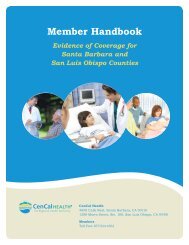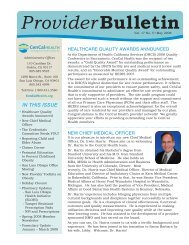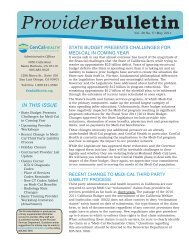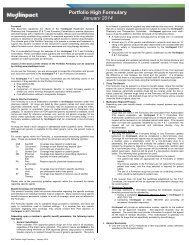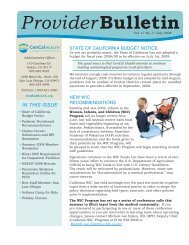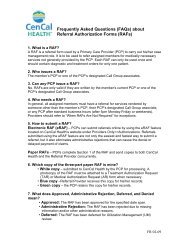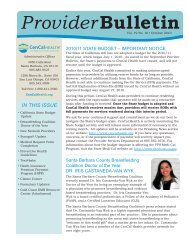Addressing Language Access Issues in Your Practice: A Toolkit for ...
Addressing Language Access Issues in Your Practice: A Toolkit for ...
Addressing Language Access Issues in Your Practice: A Toolkit for ...
Create successful ePaper yourself
Turn your PDF publications into a flip-book with our unique Google optimized e-Paper software.
21 CALIFORNIA ACADEMY OF FAMILY PHYSICIANS<br />
Side-by-side comparison of face-to-face and telephonic <strong>in</strong>terpreter use<br />
Use a face-to-face <strong>in</strong>terpreter:<br />
• For patients with any degree of hear<strong>in</strong>g loss. Obviously, if the patient’s ability to hear is at issue, use of a telephone<br />
will be difficult.<br />
• For patients from very traditional cultures, who are unaccustomed to us<strong>in</strong>g the telephone. Some refugees and<br />
immigrants may have lived, until com<strong>in</strong>g to the United States, <strong>in</strong> areas where telephone services were very limited.<br />
They may not be used to telephones. For them, the use of a telephonic <strong>in</strong>terpreter may be quite unsettl<strong>in</strong>g and may<br />
get <strong>in</strong> the way of clear communication with the physician.<br />
• When patients are afraid or distraught. The physical presence of an <strong>in</strong>terpreter may be both reassur<strong>in</strong>g and<br />
vital if the patient is upset, distraught, or <strong>in</strong> some other way deal<strong>in</strong>g with strong emotions.<br />
• When deliver<strong>in</strong>g bad news. Deliver<strong>in</strong>g bad news should be done <strong>in</strong> person. Nobody should f<strong>in</strong>d out over the<br />
telephone that they have a term<strong>in</strong>al disease, or that their child is likely to be de<strong>for</strong>med, or that their mother just<br />
died.<br />
• For a new patient’s <strong>in</strong>itial visit. On-site <strong>in</strong>terpreters usually do more than just <strong>in</strong>terpret the patient-physician<br />
<strong>in</strong>teraction. They also help patients become com<strong>for</strong>table with the office sett<strong>in</strong>g. Once a patient learns where to check<br />
<strong>in</strong> and what documents to br<strong>in</strong>g, he/she may be able to do just f<strong>in</strong>e with a telephonic <strong>in</strong>terpreter to handle the actual<br />
medical <strong>in</strong>terview.<br />
• For any k<strong>in</strong>d of conversation with more than two participants. When there are more than two speakers <strong>in</strong> a<br />
conversation, it is very hard to manage the flow of the conversation well over the phone, lead<strong>in</strong>g to <strong>in</strong>accurate <strong>in</strong>terpretation.<br />
Examples of such encounters might be: family conferences or sessions <strong>in</strong>volv<strong>in</strong>g multiple physicians.<br />
• For visits <strong>in</strong>volv<strong>in</strong>g teach<strong>in</strong>g, especially if visual aids or a demonstration are used. If you are us<strong>in</strong>g a visual<br />
aid to teach or to demonstrate a process to a patient, an on-site <strong>in</strong>terpreter is more likely to be able to reference what<br />
the physician is po<strong>in</strong>t<strong>in</strong>g to than a telephonic <strong>in</strong>terpreter who cannot see the teach<strong>in</strong>g aid. Examples of this might<br />
be: teach<strong>in</strong>g a diabetic patient to measure his/her blood sugar, teach<strong>in</strong>g a patient to use an <strong>in</strong>haler, or demonstrat<strong>in</strong>g<br />
on a model how a particular procedure will be done.<br />
• For psychiatry or any mental health encounter. The build<strong>in</strong>g of trust that is fundamental to mental health<br />
work is more easily done <strong>in</strong> person than over the phone. Patients with severe mental disturbances may f<strong>in</strong>d a disembodied<br />
voice com<strong>in</strong>g from a speakerphone to be upsett<strong>in</strong>g. In addition, <strong>in</strong>terpreters often have to <strong>in</strong>tervene <strong>in</strong><br />
mental health encounters to provide cultural frameworks <strong>for</strong> what was said; this is difficult to do telephonically.<br />
• For any sight translation. Obviously sight translation, <strong>in</strong> which an English language document is read to a<br />
patient <strong>in</strong> a different language, cannot be done over the phone, s<strong>in</strong>ce the <strong>in</strong>terpreter cannot see the document to<br />
read it.



